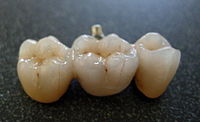
Photo from wikipedia
Many periodontal patients may need orthodontic treatment. Alterations in oral environment particularly the reduction of pH in periodontal patients could affect metal ion release from orthodontic appliances. However, there is… Click to show full abstract
Many periodontal patients may need orthodontic treatment. Alterations in oral environment particularly the reduction of pH in periodontal patients could affect metal ion release from orthodontic appliances. However, there is no study on metal ion release in periodontal patients. The aim of this preliminary study was to comparatively evaluate, for the first time, salivary levels of nickel and chromium in periodontal patients (versus healthy controls) under orthodontic treatment for 2 months. In this in vivo study, 40 subjects were evaluated. Patient selection and standardization of orthodontic treatment protocols were prospectively designed and performed. Two groups of n = 20 each (control: healthy orthodontic patients, cohort: orthodontic patients with periodontitis) underwent similar protocols of fixed orthodontic treatment for 2 months. After 2 months, salivary nickel and chromium concentrations of the case and cohort groups were measured using inductively coupled plasma mass spectrometry (ICP-MS). The values were compared between the two groups using t test. There were 10 men and 10 women in each group. The mean age of patients was 34.6 ± 3.6 years old. The salivary level of nickel was 338.2 ± 235.5 ng/ml and 182.8 ± 116.5 ng/ml in the cohort and control groups, respectively (P = 0.0118). The salivary level of chromium was 7.4 ± 3.15 ng/ml in the cohort and 6.35 ± 2.39 ng/ml in the control group (P = 0.2214). Salivary level of nickel might be considerably higher in periodontal patients undergoing 2 months of orthodontic treatment compared to orthodontic patients with healthy gingivae.
Journal Title: Biological Trace Element Research
Year Published: 2018
Link to full text (if available)
Share on Social Media: Sign Up to like & get
recommendations!